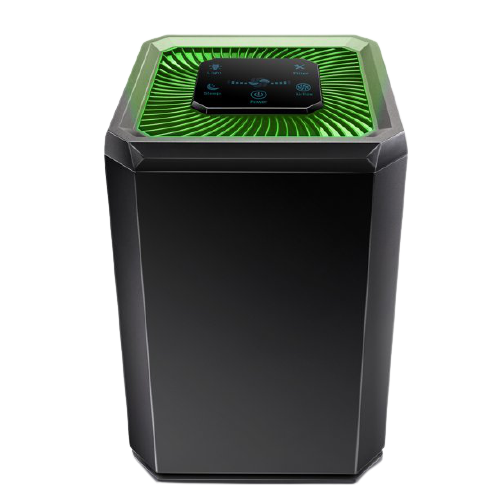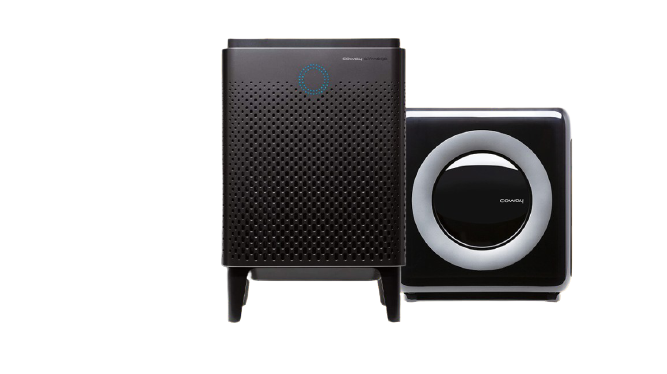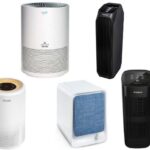Most importantly, VOCs stand for volatile organic compounds, and we may amass them in cleaners, paints, or other stuff. But do air purifiers remove VOCs? Do air purifiers get rid of VOCs? The answer to this question is a complicated one. Some purifiers work by trapping the VOC molecules, but others rely on changing the air stream in the room, which can be effective for people with allergies. The complicated nature of this question is compounded by the individualized needs of each person, as well as the different types of appliances available to the public.
Much research has been done on this topic because of the recent interest in the idea that air purifiers may help chemically sensitive people due to their ability to remove VOCs from the air.

What are VOCs?
The U.S Environmental Protection Agency (EPA) states, Volatile organic compounds are toxic chemicals emissions of certain solids and Liquids as gasses, some of which are short and long-term adverse health effects Such as damage to your brain, liver, or kidneys; cancerous tumors on lungs; Headaches, dizziness, etcetera.
Unfortunately, there are many types of toxins that people have to avoid. The most common type is VOCs – chemicals used as ingredients in everyday products and materials which carry a variety of health implications when present in the air or absorbed into our bodies.
According to the US Geological Survey, VOCs are emitted by a wide array of products numbering in the thousands. They report that concentrations of these chemicals indoors can be up to ten times higher than outdoors and they pose human-health or ecological concerns when encountered from using common household goods such as gasoline pumps for fuel or chlorine bleach used in laundry detergent.
Identifying the origins of VOCs is crucial to mitigating their negative effects. Since there are many types and sources of VOC, they can be difficult to manage when we don’t understand how or where they form. There is a range of methods that can help you keep these volatile organic compounds out of your environment, so don’t panic!
Volatile organic compounds sources
VOCs are found in various places, from the building materials used to make homes and offices to the supplies you use to clean your home or office.
Volatile organic compounds, also known as VOCs, are created by paints, varnishes, lacquers, adhesives, and pesticides. A household with pets might emit urine that contains cat-specific volatile organic compounds such as hesperidin tri hydrogen sulfide.
Sources are numerous, but here is a shortlist that commonly affects chemical workers:
- Acetone
- Benzoyl chloride
- Bromoacetophenone
- Carbonyl sulfide
- Chlorobenzene
- Ethyl acetate
- Methyl ethyl ketone
- Methyl.
Sources of VOCs
| Materials of Building | Home Products & Personal Care | Activities |
|
|
|

Volatile organic compounds list
Volatile Organic Compounds are the MOST harmful as well as those that are likely to cause eye irritation and respiratory problems.
Here is a list of some volatile organic compounds (VOCs).
- Propionaldehyde
- Methacrolein
- Acetaldehyde
- Butane -Polycyclic aromatic hydrocarbons (PAHs) such as Benzo(a)pyrene, which is found in coal tar,
- Creosote,
- Coke oven emissions,
- Heavy petroleum;
- Tobacco smoke;
- Some car exhaust gases;
- Oil refineries or oil spills
It is important to note that these are potential carcinogens, so major exposure by inhalation should be avoided.
Are VOCs Dangerous?
Yes, VOCs are extremely dangerous! They can lead to serious health problems once enough exposure is present. As the American Lung Association tells us, VOCs are harmful chemicals that can cause cancer. They also form other pollutants when they’re in the air. We should exercise caution with these toxic substances especially if there is a lack of ventilation or filtration systems at work/in our homes.
Which VOCs are Dangerous?
VOCs are found in many household products. From cleaning supplies to paints, they can be concealed in anything that is sold at your local grocery store or hardware shop. Although these VOCs are usually harmless, it’s best to play them safely and avoid direct contact with them when possible. When using or storing any product that contains one of the following chemicals, make sure to store your supplies safely and away from living spaces such as garages or sheds – here is a list:
- Acetone
- Benzene
- Butanal
- Chloroethyl Methylene
- Dichlorobenzene
- Ethanol
- Formaldehyde
- Sulfur Dioxide
- Terpenes
- Toluene
- Xylene
VOC Exposure Limits
TECAM, a group of environmental technology experts and engineers specializing in measuring TVOC (total concentration of multiple VOCs), has stated that “TVOC can be measured in micrograms per cubic meter, milligrams per cubic meter, parts-per million ppm or ppb.”
According to TECAM’s chart below:
| TVOC Level mg/m3 | Level of Concern | Example |
| Less than 0.3 mg/m3 | Low | Painting a Room |
| 0.3 to 0.5 mg/m3 | Acceptable | Disinfecting a Bathroom |
| 0.5 to 1 mg/m3 | Marginal | Automotive Garage Fumes |
| 1 to 3 mg/m3 | High | Spraying Pesticides Inside |
VOC levels become dangerous when they are over 10 ppm.
VOCs health effects.
Due to their negative health effects, VOCs are known as air pollutants.
Some VOCs cause eye, nose, and throat irritation. They can also affect your breathing or make you feel tired and dizzy, with negative impacts on the liver, kidneys, and central nervous system (CNS).
VOCs include a variety of chemicals that lead to various physical symptoms such as headaches from irritating fumes in addition to other more serious issues like damage to the CNS or even organ failure.
In Los Angeles, 85% of our particulate matter comes from VOCs. This number is even higher in cities like New Delhi (90%), Beijing (95%), Mexico City (99%), etc.
VOCs environmental effects
The presence of VOCs in the atmosphere is not only responsible for forming ozone and fine particulates but also for helping them to form. This chemical reaction between nitrogen oxides emitted from vehicles, power plants, and industrial activities helps create both ozone as well as a fine particulate matter under sunlight.
How to reduce VOCs in home?
Most people want to know how they can reduce the VOCs in their homes. There are many ways to do this, and we will look at some of them now!
Increase Ventilation
Air ventilation is essential for reducing harmful chemicals in the home, but only if you are careful about which outdoor air to let inside. Before opening windows to allow fresh air into your house, check the quality of external conditions, and ensure it’s safe before allowing polluted particles indoors with a good flow of clean filtered oxygen from outside.
Instillation an Air Purifier
Portable air purifiers are the perfect solution to clean your home or office of harmful organic chemicals. Newer, high-efficiency filters in Air purifiers can trap particles as small as dust and debris. They also contain multiple filters that include ones to catch nanoparticles like VOCs! Some styles even work with compatible indoor air quality monitors, so you know exactly how much risk when breathing hazardous materials.
Add Potted Plants to the Building
People have known for a long time that certain houseplants can absorb toxins from the air. Some research now shows bromeliad, jade, and dracaena are among those plants with this ability. When these are released into your home environment, it can cause lung distress, but potted plants will keep you healthy mentally and physically!
Never Allow Cigarette Smoke Indoors
Smoking is dangerous because it emits toxins such as formaldehyde and benzene. It can cause a number of harmful illnesses and affects the lungs and the circulatory system. Not only does it cause respiratory and heart diseases, but it can also lead to lung cancer. Even if smoking opens a window for ventilation, secondhand smoke can still seep into walls, flooring, and furniture.
The best way to eliminate risks correlated with cigarette smoke is never to allow it indoors; this includes washing every nonporous surface in your home or building that previously belonged to smokers along with replacing all linens, carpets & upholstery.
Choose a Good Dry Cleaner
Dry cleaners who offer laundry and dry cleaning services should always ensure that clothes are free of chemical odors before return.
If clothing is returned from dry cleaning, it should not have a chemical aroma. If there is an odor, the compounds used to clean them were not correctly removed during washing and will be inhaled by whoever wears them next.
It’s recommended that you ask for proper drying at your local establishment or seek out a new one if this happens again, as chemicals can cause respiratory issues over time!
Do air purifiers remove VOCs?
Yes, air purifiers typically use a filter to rid the polluted air from VOCs. According to the Environmental Protection Agency, VOCs in your home can be harmful to your health. Luckily, you might have an effective solution right under your nose—an air purifier!
But you must know which type of air purifier works best for reducing VOCs, and others won’t help much with this task at all.
Not every kind of air filter is built to take care of volatile organic compounds (VOC). Some are good about trapping particles like dust or pollen but do little against those pesky molecules suspended in our homes’ atmospheres–that will just pass right through them because they’re designed differently than filters meant specifically for chemicals such as formaldehyde, benzene, etc., common pollutants found indoors due to things like cigarette smoke; new furniture off-gassing.
So, if you’re looking for a good way to reduce VOCs in your home environment, an effective option would be either a high-quality activated carbon filtration system or one that uses activated charcoal filters.
You’ll not only be able to eliminate the harmful chemicals in the environment with this air purifier, but it will also help eliminate bad smells and odors in your home.
If you’re looking for high-quality air purifiers that can take care of both particles and VOCs, then it’s best to check out HEPA filters with activated carbon.
Do HEPA Filters Remove VOCs?
Unfortunately, HEPA filters cannot filter out VOCs because they are smaller than the 0.3 micrometre diameter that is required to be filtered by a HEPA filter. Therefore these pollutants will pass right through and cause damage to your home environment.
There is only one way to remove VOCs from the air, and that’s with an activated carbon filter. These filters are more effective at reducing VOCs than HEPA filters, which means they’re a better choice if you want an air purifier that reduces odors in your home.
FAQ
Hopefully, if you are here, it means that the article has piqued your interest, and now you have some questions. I’ll answer a few of them below in order to hopefully clear up any confusion on your part regarding do air purifiers remove VOCs?
1. What is a safe level of VOCs?
Some people believe that VOCs are chemicals that have the potential to have a variety of negative effects on the human body if inhaled. The more you contact VOCs, the greater your risk of severe medical conditions or symptoms like asthma, headaches, and eye irritation.
To reduce exposure to these harmful substances, try lowering levels in your home by ventilating rooms during use; for example, turn on a fan while showering! If something is not adding up, don’t be afraid to consult with a doctor because they may take this opportunity to rule out another potential/serious disease.
This input explains what Volatile Organic Compounds (VOC) are and how they affect our health when we experience prolonged exposure; however, it lacks engagement from the reader due to its lack of background information about why people.
2. Should I test my home for VOCs?
If you are concerned about potential VOC exposure in your home, it may be a good idea to test for VOCs. VOC testing can help you identify if and where VOCs are present in your home and at what levels.
VOC testing can be done by a professional indoor air quality (IAQ) consultant, who can perform a variety of tests to determine the presence and concentration of VOCs in your home. Alternatively, there are also home VOC testing kits available for purchase, although it is important to carefully follow the instructions and understand the limitations of these kits.
Ultimately, whether or not to test for VOCs depends on your specific concerns and situation. If you have unexplained health symptoms or have recently painted, installed new flooring, or used other products that may emit VOCs, it may be a good idea to have your home tested for VOCs.
3. How long does it take for VOCs to dissipate?
The time it takes for VOCs (volatile organic compounds) to dissipate depends on a variety of factors, including the specific VOC, the concentration, the ventilation of the area, and the temperature and humidity.
Some VOCs may dissipate quickly, within a few hours or days, while others can persist for months or even years. In general, the fresher the source of the VOC, the faster it will dissipate.
To help speed up the dissipation process, you can increase ventilation by opening windows and using fans to circulate air, use air purifiers with activated carbon filters, and minimize the use of products that emit VOCs, such as paints, adhesives, and cleaning products. It is also important to follow any safety instructions provided by the manufacturer or professional when using products that emit VOCs.
4. How to remove VOCs from air?
VOCs, or volatile organic compounds, can be removed from the air through several methods:
- Ventilation: One of the easiest ways to remove VOCs from indoor air is by increasing ventilation. Opening windows and using exhaust fans can help bring fresh air into the space and dilute the concentration of VOCs.
- Activated carbon filters: Activated carbon filters are designed to adsorb volatile organic compounds, removing them from the air. These filters can be installed in air purifiers or ventilation systems.
- Photocatalytic oxidation (PCO): This process involves using a special type of material, such as titanium dioxide, to react with VOCs and break them down into harmless byproducts. PCO systems are often used in conjunction with air purifiers.
- Zeolite: This is a natural mineral that can adsorb and trap VOCs. Zeolite can be used in air purifiers or in sachets placed around the home.
- Plants: Certain houseplants, such as spider plants, peace lilies, and rubber plants, are known to help remove VOCs from the air. These plants can be used in conjunction with other air-cleaning methods for the best results.
It’s important to note that the most effective method of removing VOCs from indoor air will depend on the specific types and concentrations of VOCs present, as well as other factors such as humidity levels and ventilation.
Conclusion
If you’ve suffered from respiratory issues like allergies or other conditions, then your indoor air quality (IAQ) may be to blame. That’s because VOCs in the home can contribute to these problems and affect people who might otherwise not have any reaction at all.
Thankfully there’s a solution- air purifiers! These devices remove particles and gases like VOCs so they can no longer affect the health of those who live with them. But do air purifiers actually remove VOCs? A question many of us ask ourselves when looking for an air purifier. What is worse, some experts believe it may be impossible to remove VOCs from the air completely. Even with great air filters. But not all air purifiers are created equal; if you want an effective unit for removing these harmful substances, we recommend purchasing one of our top models today.
For more information on what makes our best air purifier for VOCs such a great option, click here now!





Here, you can find lots of online slots from top providers.
Players can experience classic slots as well as new-generation slots with vivid animation and interactive gameplay.
Even if you’re new or a seasoned gamer, there’s something for everyone.
All slot machines are ready to play 24/7 and designed for desktop computers and tablets alike.
All games run in your browser, so you can start playing instantly.
The interface is intuitive, making it simple to explore new games.
Sign up today, and discover the world of online slots!